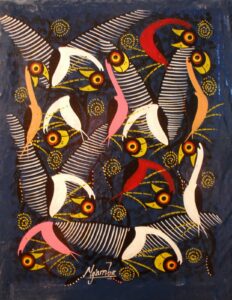

Tingatinga is a painting style originally from Dar es Salaam in Tanzania. Named after its founder Edward Said Tingatinga, it is characterized by cheaply produced canvases depicting funny, caricatured, brightly rendered images of native wildlife, people and scenery. Untitled, above, makes use of an unusually deep blue background against which the streaks of white feathers, yellow beaks and the red outline of circular eyes stand out. Typically it is very decorative and simplifies shapes into patterns which cover the small canvas. The glossy surface of the enamel-painted canvas makes an attractive object which leads the eye around these boldly defined elements.
Like the typical multi-zebra-printed images on tablecloths, T-shirts and other kitsch merchandise, the Tingatinga style can be seen to capture a standardized image of life for a tourist audience. They do not portray a realistic reality but uphold a stereotyped image of tropicalness, a fantasy safari. The vivid colouring and bold black outlines of animals in Untitled, below, is both surreal and cartoon-like. It is a bit disturbing. The wide eyed animals seem to be captured in a moment of suspicion or madness. And the rounded eyes of the bubble-bodied beasts are what stand out against the flat green terrain. All the obvious animals are lined up like characters in an animated Disney film.
Their vibrancy and playfulness remind me of Picasso’s simplistic line sketches of animals but also Warhol’s screen-printed soup cans and Jeff Koons’ Balloon Dog. Like Koons and Warhol the Tingatinga style clearly relates to the kitsch aesthetic, the quick and cheap production method which in turn gains an associated value. Although a Picasso squiggle, a Warhol print blotch or a maquette by Koons’ assistants would command the prices of a fine art market, Tingatinga paintings may sell for a more modest price. It is both a pro and a con that, like a souvenir, the boldly defined images have a disposable reading to them. The bright colours and delineated forms are momentarily striking but they do not live long in the memory and do not provoke deep contemplation or pleasure. They are a momentary gesture meant to evoke nostalgia in the shallowest and most generalised way. Pop art and Contemporary art often do this ironically to subvert the nature of value. Koons’ Balloon Dog (1994-2000) is an illusion of a blown up balloon dog which might have been commonly produced by a clown at the circus. It is actually a meticulous metal construction, created to permanently record kitsch, throwaway subjects, and to elevate them in the fine art arena. That is what makes it interesting. The juxtaposition between “high” and “low” art creates a fascinating dynamic. Whereas the Tingatinga has not evolved beyond the souvenir. It remains kitsch and decorative, not cheeky kitsch.




Leave a Reply